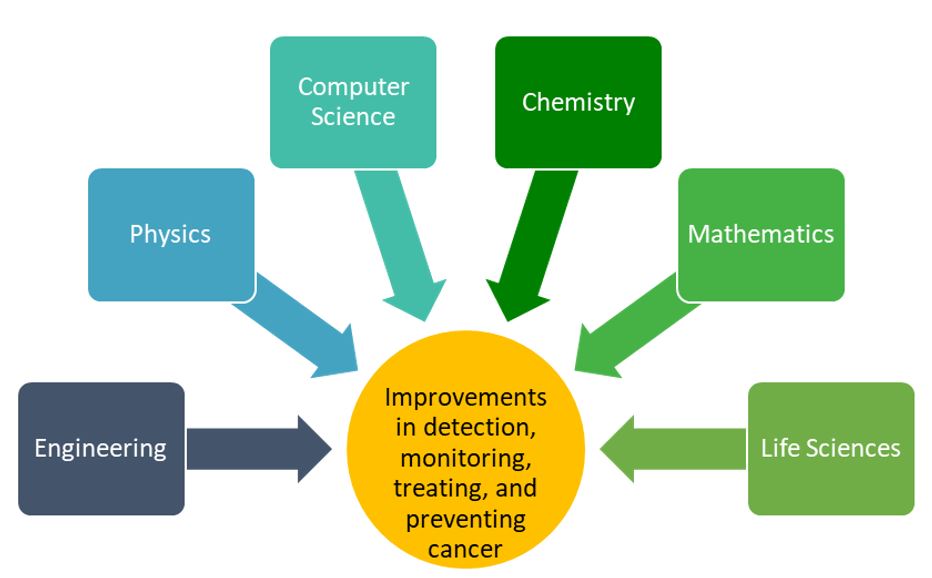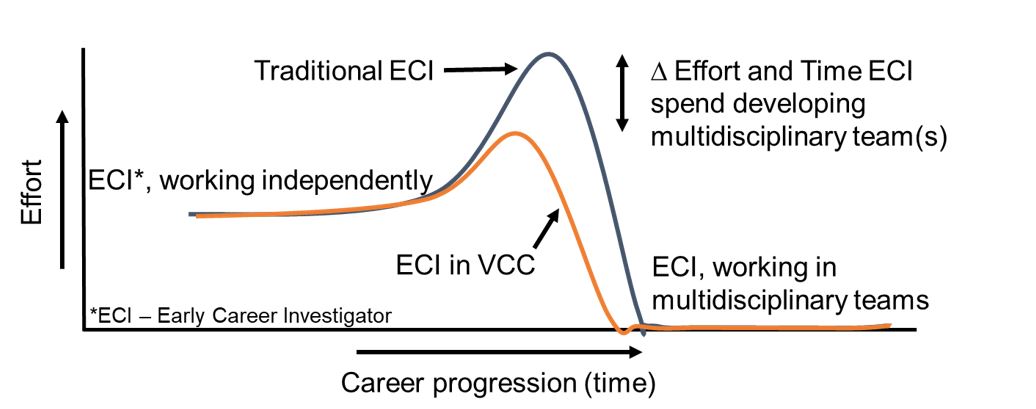Peer Reviewed Cancer



Posted May 29, 2020
Amie D. Bunker, Ph.D. and Donna M. Kimbark, Ph.D.
For Fiscal Year 2020 FY(20), the Peer Reviewed Cancer Research Program (PRCRP) offers a prestigious opportunity for an established researcher to lead the next generation of researchers toward a future in cancer. The Virtual Cancer Center Director Award (VCCDA) mechanism is a unique, interactive virtual cancer center (VCC) focused on bringing together two established investigators (Director and Deputy Director) and up to nine early career investigators (Scholars) to interrogate the commonalities of cancer. As the leadership of the VCC, the Director and Deputy Director will have the ability to shape the vision VCC and how it will succeed in its mission to train the next generation of cancer researchers.
It is the expectation of the PRCRP that through the VCCDA funding award mechanism, an environment of collaboration and convergent training will be created (see below). The FY20 PRCRP VCC offers the Director and Deputy Director the opportunity to influence the next generation of cancer research by catalyzing the growth and professional development of the Scholars and promoting the cross pollination of different cancer disciplines. Candidates for Scholars will apply to a separate funding opportunity, the Career Development Award – Virtual Cancer Center Scholar Option (CDA-SO). The VCC will give the Director, Deputy Director, and Scholars opportunities to operate in a collegial, highly dynamic, and cutting-edge center to lead cancer research to a new frontier. The VCC will provide intensive mentoring, national networking, collaborations, and a peer group for junior faculty. It is the intention that through the VCC, collaborations will foster new growth in different cancers and spur an integrated cancer center to ensure research advancements across different cancers.
The potential outcomes of the VCCD and CDA-SO include integration of research from different disciplines and cancers, forging a new frontier in cancer research that will lead to answers across the cancer care spectrum (Biology/Etiology, Prevention, Diagnosis/Detection, Prognosis, Treatment, and Survivorship) and building a multidisciplinary, multi-institutional research community capable of proposing convergent solutions to FY20 PRCRP Topic Areas issues. Through these award mechanisms, the FY20 PRCRP looks to fund answers that are responsive to more than one cancer, that information learned in one cancer or discipline informs other cancers and/or disciplines. Convergence in science supports innovation and answers age-old problems. With the VCCDA and the CDA-SO the PRCRP intends to grow and broaden cancer research understanding through a diverse community from many disciplines and a variety of cancers.
Introduction to Convergence Science
In broad terms, convergence science integrates knowledge, tools, and ways of thinking from multiple disciplines to form a comprehensive framework for tackling scientific and societal challenges that exist at the interfaces of multiple fields. Some of the biggest scientific achievements, particularly in the last few decades, were accomplished because researchers from across several disciplines came together to work toward a single goal (Figure 1). The goals of convergence science include assembling the expertise necessary to address defined problems and enabling the experts from multiple fields to form partnerships that allow the resultant findings to be translated for societal benefit.1

Figure 1. Convergence science integrates knowledge, tools, and ways of thinking from life, health, physical, mathematical, and computational sciences; engineering disciplines; etc., providing a comprehensive framework for forming multidisciplinary teams to tackle complex scientific problems.1
Dr. Robert S. Langer and Dr. Phillip A. Sharp, both Institute Professors at the Massachusetts Institute of Technology and members of the Koch Institute for Integrative Cancer Research, were the first to use the phrase “convergence science” in the context of solving complex problems related to human health issues.2 Today, there are multiple reports documenting the key attributes of convergence science and its implementation to tackle contemporary research challenges; these reports have been collated by the National Science Foundation.3
Building Multidisciplinary Teams
Despite the general acceptance that multidisciplinary teams are key to moving innovations in human health research from the bench to the bedside, challenges in assembling such teams remain.4 The complexity and specialization exhibited across scientific fields present difficulties for a researcher trying to identify the best discipline(s) to synergize with their efforts. There is also a social aspect to collaboration. Researchers tend to collaborate with investigators that are familiar (e.g., similar personal history, work style, locality). Finally, there can be either real or perceived “power differentials.” An early career investigator (ECI) may find it difficult to reach out to a collaborator who is well established in their field. Therefore, evidence shows that without working within a formalized multidisciplinary network, investigators are more likely to collaborate with investigators at their same site, collaborate with investigators of similar background (e.g., clinicians collaborating with clinicians, researchers collaborating with researchers, etc.), and/or collaborate with investigators with whom they have previously collaborated.5
The Translational Cancer Research Network (TCRN), formed in Australia in 2011, offers a model of convergence science.6 The TCRN started with a network of 60 members who spanned multiple hospitals, universities, and research centers, and who were from disciplines as diverse as clinical care, protein chemistry, health economics, and genetics. By 2015, survey responses from the then 244-member TCRN revealed 671 new collaborative ties across the network, evidence of the valuable networking opportunities provided through TCRN membership.7 The TCRN has continued to grow. As of 2019 it was a network consisting of 350 clinicians, doctoral level researchers, patient advocates, and other stakeholders6. Those interested in learning more about the success of and barriers lowered by the TCRN are encouraged to read references 5, 7, and 8.
Other models of convergence science networks/initiatives include the Koch Institute for Integrative Cancer Research at MIT (established in 2010),9 the Chan Zuckerberg Initiative (established in 2015),10 and the Parker Institute for Cancer Immunotherapy (established in 2016).11
Establishing the PRCRP VCC
An important strategic goal of the Peer Reviewed Cancer Research Program (PRCRP) is to build a strong foundation of ECIs to expand the knowledge base of cancers and research areas funded under the PRCRP (Table 1).
Table 1: List of Fiscal Year 2020 Peer Reviewed Cancer Research Program Topic Areas*
|
|
|
*Topic Areas are subject to change from one fiscal year to another. Refer to the PRCRP Topic Areas found at the PRCRP web page for more information: https://cdmrp.health.mil/prcrp/topicareas/topicareas20
Additionally, there is increasing recognition that tumors cannot just be described in terms of the tissue of origin (e.g., bladder cancer, stomach cancer, etc.), but that there are commonalities across tumor types. As evidence of this shifting view of cancer, in 2017 the Food and Drug Administration (FDA) set a new precedent by granting Keytruda (pembrolizumab) Priority Review and Accelerated Approval based on a biomarker instead of a tissue of origin. The FDA has since approved two additional tissue agnostic cancer therapies (i.e., therapies approved based on a biomarker rather than tissue of tumor origin), Vitrakvi (larotrectinib) in 2018 and Rozlytrek (entrectinib) in 2019. The continued development of biomarker-driven, tissue agnostic therapeutic options has great potential to transform cancer treatment.12 The PRCRP is well-positioned to invest in a strong foundation for ECI from multiple PRCRP-funded Topic Areas who are capable of conducting cutting-edge research and accelerating research in convergence science.13

Figure 2. Conceptualized graph of the expectation that ECIs in Cross Disciplined Cancer Center (e.g., VCC Scholars) will spend less time and effort to establish multidisciplinary teams in their PRCRP Topic Area.
New for FY20, and building off the precedent set by the Ovarian Cancer Research Program in FY09 to fund The Ovarian Cancer Academy (ovariancanceracademy.org), the PRCRP is offering a funding opportunity to establish a VCC. The VCC will establish a supportive network to catalyze career development and collaboration by providing access to mentors and research partners across diverse backgrounds. The objective of the PRCRP VCC is to shift away from the single-discipline approach to cancer research and broaden the abilities of the next generation of researchers as shown in Figure 2. Importantly, the VCC will provide a forum that alleviates any real or perceived “power differentials” between ECI sand established investigators.
The Leadership of the PRCRP VCC will include a Director and a Deputy Director ( VCCDA). The VCCDA offers a unique and extraordinary opportunity for established investigators to lead a network of highly qualified ECIs (Scholars) from diverse research backgrounds and to set their Vision of the future of cancer research. The Scholars of the VCC will apply to a separate funding opportunity, the CDA-SO . The Scholars will each have their own designated Career Guides, in addition to the mentoring and career development activities offered under the VCC. The PRCRP offers the CDA-SO as a novel opportunity for ECIs who show promise to become leaders not only in their individual fields but also in cancer research in general. The VCC will be open to any eligible ECI who conducts research in at least one of the PRCRP FY20 Topic Areas; the VCC will not be specific to a single cancer type. The VCC Leadership and CDA-SO Career Guides will work together to develop successful, highly productive ECIs in a collaborative research and career developmental environment. Through the VCCDA and CDA-SO, the PRCRP seeks to lead the way toward the future of cancer research with innovative, provocative, and convergent science.
References
- National Research Council. 2014. Convergence: Facilitating Transdisciplinary Integration of Life Sciences, Physical Sciences, Engineering, and Beyond. Washington, DC: The National Academies Press. https://doi.org/10.17226/18722
- Sharp PA and Langer R. 2011. Promoting convergence in biomedical science. Science. 333(6042):527. doi: 10.1126/science.1205008. PubMed PMID: 21798916.
- “Studies of Convergence.” National Science Foundation, https://www.nsf.gov/od/oia/convergence/reports.jsp
- Savage N. 2018. How team science extends your scope. Nature. 556:S1-S3.
- Long JC, Cunningham FC, Carswell P, and Brathwaite J. 2014. Patterns of collaboration in complex networks: the example of a translational research network. BMC Health Services Research, 14:225.
- Translational Cancer Research Network. Cancer Institute New South Wales, http://www.tcrn.unsw.edu.au/
- Long JC, Hibbert P, and Braithwaite J. 2016. Structuring successful collaboration: A longitudinal social network analysis of a translational research network. Implement Sci. 11:19. doi: 10.1186/s13012-016-0381-y. PubMed PMID: 26864452; PubMed Central PMCID: PMC4750242.
- Long JC, et al. 2013. Leadership in complex networks: The importance of network position and strategic action in a translational cancer research network. Implement Sci. 8:122. doi: 10.1186/1748-5908-8-122. PubMed PMID: 24120075; PubMed Central PMCID: PMC385412.
- Kock Institute for Integrative Cancer Research at MIT. Massachusetts Institute of Technology, https://ki.mit.edu/
- Chan Zuckerberg Initiative. https://chanzuckerberg.com/science/
- Parker Institute for Cancer Immunotherapy. https://www.parkerici.org/
- “FDA approves third oncology drug that targets a key genetic driver of cancer, rather than a specific type of tumor.” US Food and Drug Administration, 15 August 2019, https://www.fda.gov/news-events/press-announcements/fda-approves-third-oncology-drug-targets-key-genetic-driver-cancer-rather-specific-type-tumor.
- “Peer Reviewed Cancer Research Program Strategic Plan.” CDMRP, https://cdmrp.health.mil/prcrp/pdf/PRCRP%20Strategic%20Plan.pdf.
Last updated Thursday, December 5, 2024














